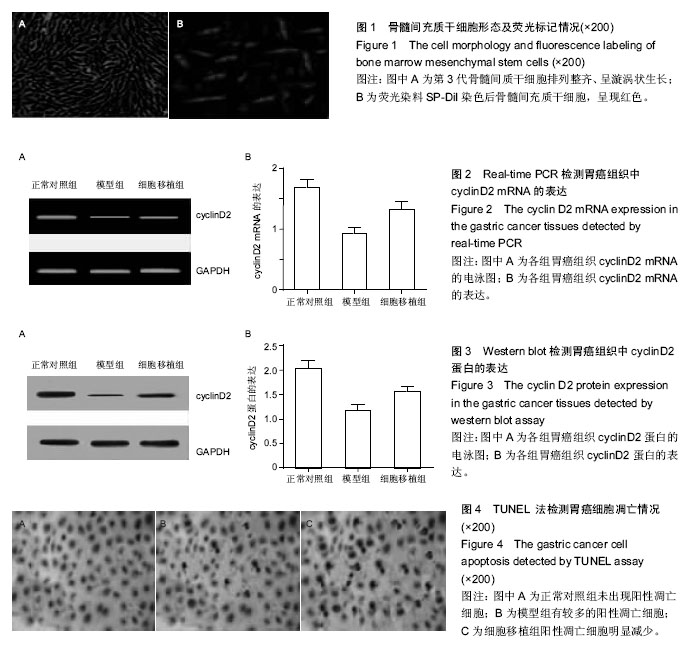| [1] Parkin DM, Bray F, Ferlay J, et al. Global cancer statistics, 2002.CA Cancer J Clin. 2005;55(2):74-108.
[2] 吴春晓,郑莹,鲍萍萍,等.上海市胃癌发病流行现况与时间趋势分析[J].外科理论与实践, 2008,13(1):24-29.
[3] Kamangar F, Dores GM, Anderson WF. Patterns of cancer incidence, mortality, and prevalence across five continents: defining priorities to reduce cancer disparities in different geographic regions of the world. J Clin Oncol. 2006;24(14):2137-2150.
[4] 谢余澄,杨亚丽,孙涛,等.骨髓间充质干细胞与胃癌的起源[J].临床医学,2012,32(8): 102-104.
[5] Takaishi S, Okumura T, Tu S, et al. Identification of gastric cancer stem cells using the cell surface marker CD44. Stem Cells. 2009;27(5):1006-1020.
[6] Houghton J, Stoicov C, Nomura S, et al. Gastric cancer originating from bone marrow-derived cells. Science. 2004;306(5701):1568-1571.
[7] Marx J. Cancer research. Inflammation and cancer: the link grows stronger. Science. 2004;306(5698): 966-968.
[8] Marx J. Medicine. Bone marrow cells: the source of gastric cancer. Science. 2004;306(5701):1455-1457.
[9] Anzalone R, Lo Iacono M, Loria T, et al. Wharton's jelly mesenchymal stem cells as candidates for beta cells regeneration: extending the differentiative and immunomodulatory benefits of adult mesenchymal stem cells for the treatment of type 1 diabetes. Stem Cell Rev. 2011;7(2):342-363.
[10] Volarevic V, Arsenijevic N, Lukic ML, et al. Concise review: Mesenchymal stem cell treatment of the complications of diabetes mellitus. Stem Cells. 2011; 29(1):5-10.
[11] Tang Y, Gan X, Cheheltani R, et al. Targeted delivery of vascular endothelial growth factor improves stem cell therapy in a rat myocardial infarction model. Nanomedicine. 2014;10(8):1711-1718.
[12] Humphreys BD, Bonventre JV. Mesenchymal stem cells in acute kidney injury. Annu Rev Med. 2008;59: 311-325.
[13] O'Loughlin A, Kulkarni M, Creane M, et al. Topical administration of allogeneic mesenchymal stromal cells seeded in a collagen scaffold augments wound healing and increases angiogenesis in the diabetic rabbit ulcer. Diabetes. 2013;62(7):2588-2594.
[14] Zhang G, Zhou J, Fan Q, et al. Arterial-venous endothelial cell fate is related to vascular endothelial growth factor and Notch status during human bone mesenchymal stem cell differentiation. FEBS Lett. 2008;582(19):2957-2964.
[15] 陈晓宇,黄陈,裘正军.早期胃癌的治疗现状与进展[J].现代生物医学进展,2015, 15(12): 2352-2354.
[16] 李涛,梁美霞,冯道夫,等.进展期胃癌综合治疗分析[J].首都医药, 2014, 21(6): 25-27.
[17] 徐学新,张炜.晚期胃癌的治疗进展[J].中国肿瘤临床与康复,2012, 18(6): 574-576.
[18] 王凯,李玉明,张明凯,等.人胃癌组织中间充质干细胞对胃癌细胞株SGC-7901增殖与侵袭能力的影响[J].中华实验外科杂志, 2014, 31(3): 480-482.
[19] Roorda BD, ter Elst A, Kamps WA, et al. Bone marrow-derived cells and tumor growth: contribution of bone marrow-derived cells to tumor micro-environments with special focus on mesenchymal stem cells. Crit Rev Oncol Hematol. 2009;69(3):187-198.
[20] 赵宝成,王振军,毛伟征,等.脐血间充质干细胞靶向胃癌移植瘤的实验研究[J].肿瘤研究与临床,2011, 23(1): 4-7.
[21] 申晶.骨髓源间充质干细胞输注促进STZ诱导的糖尿病大鼠胰腺内 α 细胞向 β 细胞的转变:糖尿病治疗的新模式[D].北京:中国人民解放军医学院, 2013.
[22] 祝荫.慢病毒载体介导NK4基因修饰骨髓间充质干细胞靶向治疗胃癌的实验研究[D].南昌:南昌大学,2010.
[23] 赵宝成.人脐血间质干细胞趋向胃癌种植瘤及其分子机制的实验研究[D] 青岛:青岛大学, 2008.
[24] 郭彤,王薇,张君,等.骨髓间充质干细胞移植治疗眼表损害的初步实验研究[J].中华眼科杂志,2006,42(3):246-250.
[25] 智晓东,吕刚.大鼠骨髓间充质干细胞和许旺细胞联合移植治疗脊髓损伤[J].中国组织工程研究与临床康复,2008, 12(16): 3015-3018.
[26] 汤庆,何小洪,向邦德,等.人脐静脉血管内皮细胞培养,冻存,复苏与鉴定[J].广州医学院学报, 2006, 34(2):60-63.
[27] 张治金,郭林,赵德伟.兔骨髓间充质干细胞与羊膜的共培养[J].中国组织工程研究,2012,16(27):4959-4962.
[28] 赵聃,李妍,周建博,等.大鼠Thy-1肾炎增殖病变及 sublytic C5b-9致其肾小球系膜细胞增生的实验研究[J].南京医科大学学报, 2012, 12(10):1343-1350.
[29] 赵蕾,朱翠敏,张志华,等.丙戊酸钠逆转Kasumi-1白血病细胞株AML1-ETO融合蛋白转录抑制的作用[J].中国实验血液学杂志, 2009,17(2):363-367.
[30] 郭晓,潘崚. ERK阻滞剂U0126对白血病细胞K562细胞周期的作用及机制[J].第三军医大学学报, 2008, 30(5): 393-395.
[31] 屈建强,杨涛,周乐. p57kip2和cyclin D2在人脑胶质瘤中的表达和临床意义[J].第四军医大学学报, 2007, 28(20): 1878-1880.
[32] 郑倩,刘红,刘华,等.果糖二磷酸钠对2型糖尿病大鼠胰岛内质网应激时CHOP和JNK 表达及胰岛细胞凋亡的影响[J].中国病理生理杂志, 2012, 28(4): 733-737.
[33] 王共先,汪泱,胡红林,等.骨髓间充质干细胞向前列腺癌趋向转移的研究[J].中华实验外科杂志, 2006, 23(5): 582-584.
[34] 宋向明,赵瑜,田长富.肿瘤基因治疗的病毒载体研究进展[J].医学综述,2014,20(6): 1006-1009.
[35] Song H, Hogdall E, Ramus SJ, et al. Effects of common germ-line genetic variation in cell cycle genes on ovarian cancer survival. Clin Cancer Res. 2008; 14(4):1090-1095.
[36] 顾立志.间充质干细胞对胃癌SGC7901细胞增殖的影响及机制的实验研究[D].徐州:徐州医学院, 2009.
[37] Sun T, Sun BC, Ni CS, et al. Pilot study on the interaction between B16 melanoma cell-line and bone-marrow derived mesenchymal stem cells. Cancer Lett. 2008;263(1):35-43.
[38] 陈军,徐祗顺,赵海峰,等.骨髓间充质干细胞在兔肿瘤组织中的分布与分化[J].中华医学杂志, 2007,87(33):2361- 2364.
[39] Karnoub AE, Dash AB, Vo AP, et al. Mesenchymal stem cells within tumour stroma promote breast cancer metastasis. Nature. 2007;449(7162):557-563. |
.jpg)

.jpg)